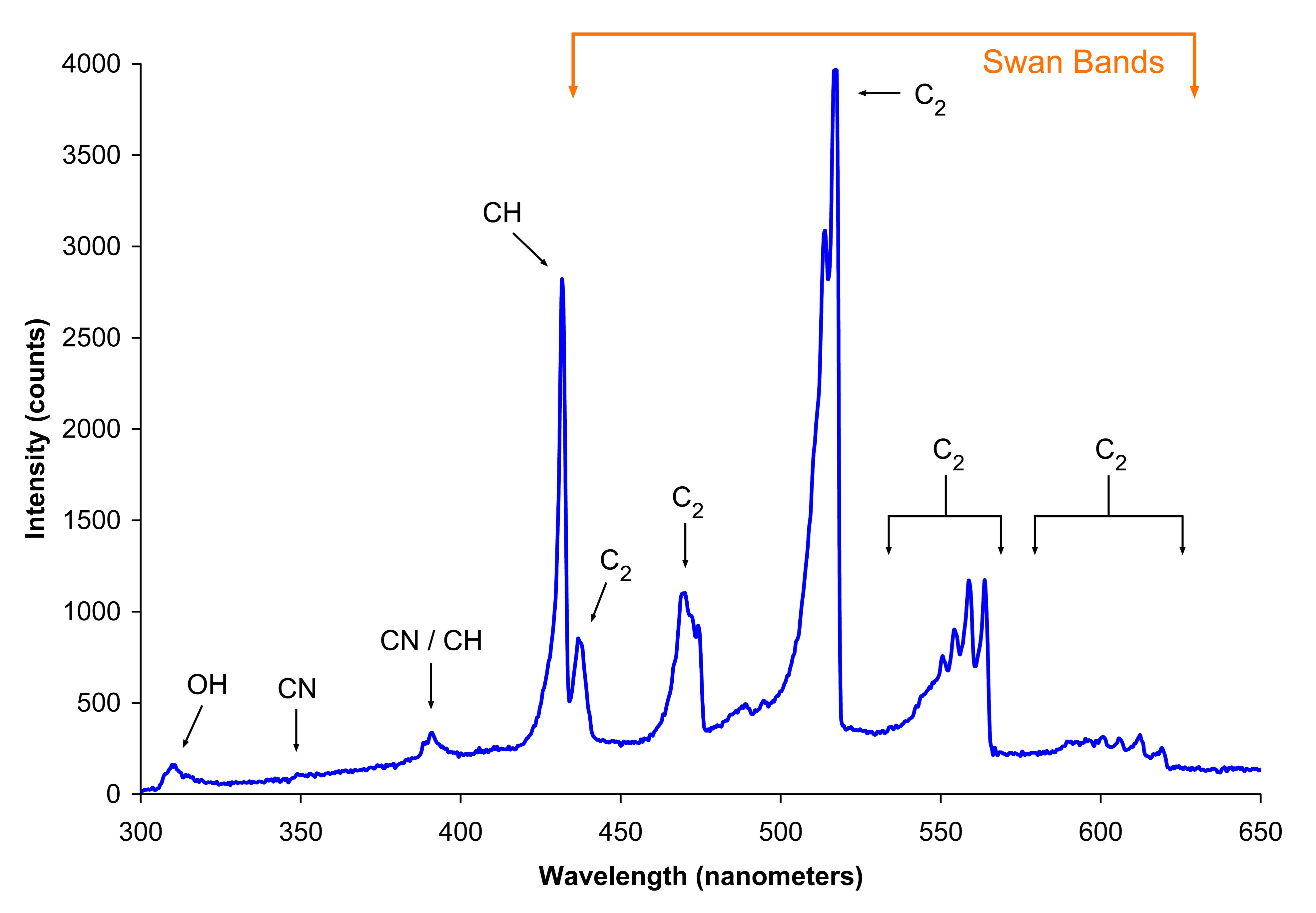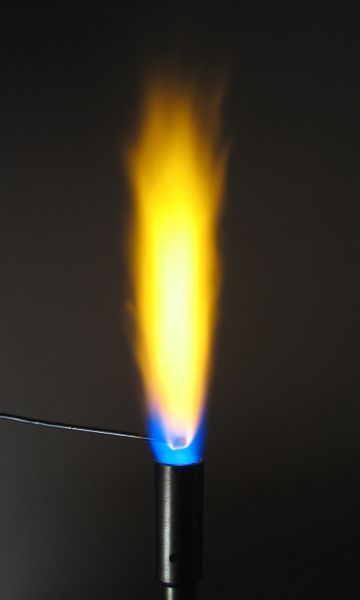Flame
Overview
A flame is often defined as the visible (light-emitting) part of a fire. Physically, it is caused by a highly exothermic reaction (for example, combustion, a self-sustaining oxidation reaction) taking place in a thin zone. A flame generally emits light, by two different mechanisms which will be described below.
The color and temperature of a flame are dependent on the type of fuel involved in the combustion, as, for example, when a lighter is held to a candle. The applied heat causes the fuel molecules in the wick to vaporize. In this state they can then readily react with oxygen in the air, which gives off enough heat in the subsequent exothermic reaction to vaporize yet more fuel, thus sustaining a consistent flame. The high temperature of the flame tears apart the vaporized fuel molecules, forming various incomplete combustion products and free radicals, and these products then react with each other and with the oxidizer involved in the reaction. Sufficient energy in the flame will excite the electrons in some of the transient reaction intermediates such as CH and C2, which results in the emission of visible light as these substances release their excess energy (see spectrum below for an explanation of which specific radical species produce which specific colors). As the combustion temperature of a flame increases (if the flame contains small particles of unburnt carbon or other material), so does the average energy of the electromagnetic radiation given off by the flame (see blackbody).
Other oxidizers besides oxygen can be used to produce a flame. Hydrogen burning in chlorine produces a flame and in the process emits gaseous hydrogen chloride (HCl) as the combustion product.[1] Another of many possible chemical combinations is hydrazine and nitrogen tetroxide which is hypergolic and commonly used in rocket engines.
The chemical kinetics occurring in the flame is very complex and involves typically a large number of chemical reactions and intermediate species, most of them radicals. For instance, a well-known chemical kinetics scheme, GRI-Mech [2] , uses 53 species and 325 elementary reactions to describe combustion of natural gas.
There are different methods of distributing the required components of combustion to a flame. In a diffusion flame, oxygen and fuel diffuse into each other; where they meet the flame occurs. In a premixed flame, the oxygen and fuel are premixed beforehand, which results in a different type of flame. Candle flames (a diffusion flame) operate through evaporation of the fuel which rises in a laminar flow of hot gas which then mixes with surrounding oxygen and combusts.
Flame color


Flame color depends on several factors, the most important typically being blackbody radiation and spectral band emission, with both spectral line emission and spectral line absorption playing smaller roles. In the most common type of flame, hydrocarbon flames, the most important factor determining color is oxygen supply and the extent of fuel-oxygen "pre-mixture", which determines the rate of combustion and thus the temperature and reaction paths, thereby producing different color hues. In a laboratory under normal gravity conditions and with a closed oxygen valve, a Bunsen burner burns with yellow flame (also called a safety flame) at around 1,000°C. This is due to incandescence of very fine soot particles that are produced in the flame. With increasing oxygen supply, less blackbody-radiating soot is produced due to a more complete combustion and the reaction creates enough energy to excite and ionize gas molecules in the flame, leading to a blue appearance. The spectrum of a premixed (complete combustion) butane flame on the right shows that the blue color arises specifically due to emission of excited molecular radicals in the flame, which emit most of their light well below ~565 nanometers in the blue and green regions of the visible spectrum.
Flame temperatures of common items include a blow torch at 1,300°C, a candle at 1,400°C [1], or a much hotter oxyacetylene combustion at 3,000°C. Cyanogen produces an ever-hotter flame with a temperature of over 4525°C (8180°F) when it burns in oxygen.[3]
Generally speaking, the coolest part of a diffusion (incomplete combustion) flame will be red, transitioning to orange, yellow, and white the temperature increases as evidenced by changes in the blackbody radiation spectrum. For a given flame's region, the closer to white on this scale, the hotter that section of the flame is. The transitions are often apparent in TV pictures of fires, in which the color emitted closest to the fuel is white, with an orange section above it, and reddish flames the highest of all. Beyond the red the temperature is too low to sustain combustion, and black soot escapes. A blue-colored flame only emerges when the amount of soot decreases and the blue emissions from excited molecular radicals become dominant, though the blue can often be seen near the base of candles where airborne soot is less concentrated.
Flames in microgravity
In the year 2000 the National Aeronautics and Space Administration (NASA) of the United States discovered that gravity also plays an indirect role in flame formation and composition. [4] The common distribution of a flame under normal gravity conditions depends on convection, as soot tends to rise to the top of a flame (such as in a candle in normal gravity conditions), making it yellow. In microgravity or zero gravity, such as an outer space environment, convection no longer occurs and the flame becomes spherical, with a tendency to become bluer and more efficient. There are several possible explanations for this difference, of which the most likely is the hypothesis that the temperature is sufficiently evenly distributed that soot is not formed and complete combustion occurs. [5] Experiments by NASA reveal that diffusion flames in microgravity allow more soot to be completely oxidized after they are produced than do diffusion flames on Earth, because of a series of mechanisms that behave differently in microgravity when compared to normal gravity conditions. [6][7] These discoveries have potential applications in applied science and industry, especially concerning fuel efficiency. A video of a microgravity flame in the NASA Glenn 5 s drop facility is at [2].
References
- ↑ Reaction of Chlorine with Hydrogen
- ↑ Gregory P. Smith; David M. Golden, Michael Frenklach, Nigel W. Moriarty, Boris Eiteneer, Mikhail Goldenberg, C. Thomas Bowman, Ronald K. Hanson, Soonho Song, William C. Gardiner, Jr., Vitali V. Lissianski, and Zhiwei Qin, GRI-Mech 3.0
- ↑ Thomas, N.; Gaydon, A. G.; Brewer, L. (March 1952), "Cyanogen Flames and the Dissociation Energy of N2", The Journal of Chemical Physics, 20 (3): 369–374
- ↑ Spiral flames in microgravity, National Aeronautics and Space Administration, 2000.
- ↑ CFM-1 experiment results, National Aeronautics and Space Administration, April 2005.
- ↑ LSP-1 experiment results, National Aeronautics and Space Administration, April 2005.
- ↑ SOFBAL-2 experiment results, National Aeronautics and Space Administration, April 2005.
ar:لهب cy:Fflam de:Flamme fa:شعله it:Fiamma lt:Liepsna nl:Vlam no:Flamme scn:Ciamma simple:Flame su:Seuneu Template:WH Template:WS